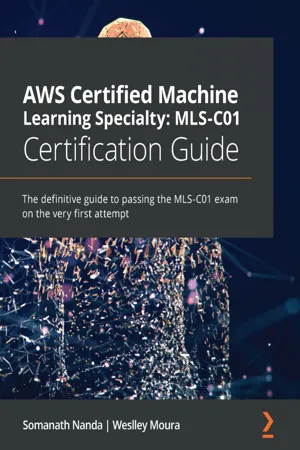
AWS Certified Machine Learning Specialty: MLS-C01 Certification Guide
The definitive guide to passing the MLS-C01 exam on the very first attempt
Somanath Nanda, Weslley Moura
- 338 pages
- English
- ePUB (mobile friendly)
- Available on iOS & Android
AWS Certified Machine Learning Specialty: MLS-C01 Certification Guide
The definitive guide to passing the MLS-C01 exam on the very first attempt
Somanath Nanda, Weslley Moura
About This Book
Prepare to achieve AWS Machine Learning Specialty certification with this complete, up-to-date guide and take the exam with confidence
Key Features
- Get to grips with core machine learning algorithms along with AWS implementation
- Build model training and inference pipelines and deploy machine learning models to the Amazon Web Services (AWS) cloud
- Learn all about the AWS services available for machine learning in order to pass the MLS-C01 exam
Book Description
The AWS Certified Machine Learning Specialty exam tests your competency to perform machine learning (ML) on AWS infrastructure. This book covers the entire exam syllabus using practical examples to help you with your real-world machine learning projects on AWS.Starting with an introduction to machine learning on AWS, you'll learn the fundamentals of machine learning and explore important AWS services for artificial intelligence (AI). You'll then see how to prepare data for machine learning and discover a wide variety of techniques for data manipulation and transformation for different types of variables. The book also shows you how to handle missing data and outliers and takes you through various machine learning tasks such as classification, regression, clustering, forecasting, anomaly detection, text mining, and image processing, along with the specific ML algorithms you need to know to pass the exam. Finally, you'll explore model evaluation, optimization, and deployment and get to grips with deploying models in a production environment and monitoring them.By the end of this book, you'll have gained knowledge of the key challenges in machine learning and the solutions that AWS has released for each of them, along with the tools, methods, and techniques commonly used in each domain of AWS ML.
What you will learn
- Understand all four domains covered in the exam, along with types of questions, exam duration, and scoring
- Become well-versed with machine learning terminologies, methodologies, frameworks, and the different AWS services for machine learning
- Get to grips with data preparation and using AWS services for batch and real-time data processing
- Explore the built-in machine learning algorithms in AWS and build and deploy your own models
- Evaluate machine learning models and tune hyperparameters
- Deploy machine learning models with the AWS infrastructure
Who this book is for
This AWS book is for professionals and students who want to prepare for and pass the AWS Certified Machine Learning Specialty exam or gain deeper knowledge of machine learning with a special focus on AWS. Beginner-level knowledge of machine learning and AWS services is necessary before getting started with this book.
]]>
Frequently asked questions
Information
Section 1: Introduction to Machine Learning
- Chapter 1, Machine Learning Fundamentals
- Chapter 2, AWS Application Services for AI/ML
Chapter 1: Machine Learning Fundamentals
- Comparing AI, ML, and DL
- Classifying supervised, unsupervised, and reinforcement learning
- The CRISP-DM modeling life cycle
- Data splitting
- Modeling expectations
- Introducing ML frameworks
- ML in the cloud
Comparing AI, ML, and DL
- Robotics
- Natural language processing
- Rule-based systems
- ML
Examining ML

Examining DL
Classifying supervised, unsupervised, and reinforcement learning
Introducing supervised learning


- Numerical/discrete data refers to individual and countable items (for example, the number of students in a classroom or the number of items in an online shopping cart).
- Numerical/continuous data refers to an infinite number of possible measurements and they often carry decimal points (for example, temperature).
- Categorical/nominal data refers to labeled variables with no quantitative value (for example, name or gender).
- Categorical/ordinal data adds the sense of order to a labeled variable (for example, education level or employee title level).
Table of contents
- AWS Certified Machine Learning Specialty: MLS-C01 Certification Guide
- Contributors
- Preface
- Section 1: Introduction to Machine Learning
- Chapter 1: Machine Learning Fundamentals
- Chapter 2: AWS Application Services for AI/ML
- Section 2: Data Engineering and Exploratory Data Analysis
- Chapter 3: Data Preparation and Transformation
- Chapter 4: Understanding and Visualizing Data
- Chapter 5: AWS Services for Data Storing
- Chapter 6: AWS Services for Data Processing
- Section 3: Data Modeling
- Chapter 7: Applying Machine Learning Algorithms
- Chapter 8: Evaluating and Optimizing Models
- Chapter 9: Amazon SageMaker Modeling
- Other Books You May Enjoy